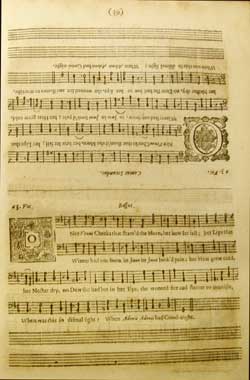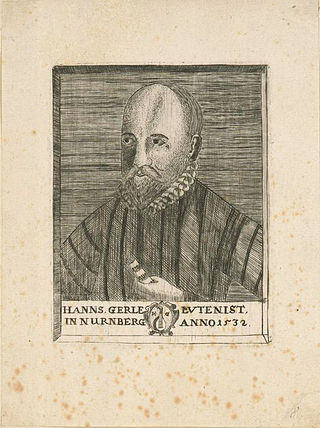
A lute is any plucked string instrument with a neck and a deep round back enclosing a hollow cavity, usually with a sound hole or opening in the body. It may be either fretted or unfretted.
This article contains information about the literary events and publications of 1507.

Francesco Canova da Milano was an Italian lutenist and composer. He was born in Monza, near Milan, and worked for the papal court for almost all of his career. Francesco was heralded throughout Europe as the foremost lute composer of his time. More of his music is preserved than of any other lutenist of the period, and his work continued to influence composers for more than a century after his death.

Jacques Arcadelt was a Franco-Flemish composer of the Renaissance, active in both Italy and France, and principally known as a composer of secular vocal music. Although he also wrote sacred vocal music, he was one of the most famous of the early composers of madrigals; his first book of madrigals, published within a decade of the appearance of the earliest examples of the form, was the most widely printed collection of madrigals of the entire era. In addition to his work as a madrigalist, and distinguishing him from the other prominent early composers of madrigals – Philippe Verdelot and Costanzo Festa – he was equally prolific and adept at composing chansons, particularly late in his career when he lived in Paris.
Johann Jakob Froberger was a German Baroque composer, keyboard virtuoso, and organist. Among the most famous composers of the era, he was influential in developing the musical form of the suite of dances in his keyboard works. His harpsichord pieces are highly idiomatic and programmatic.
Giovanni Girolamo Kapsperger was an Austrian-Italian virtuoso performer and composer of the early Baroque period. A prolific and highly original composer, Kapsberger is chiefly remembered today for his lute and theorbo (chitarrone) music, which was seminal in the development of these as solo instruments.
Luis de Narváez was a Spanish composer and vihuelist. Highly regarded during his lifetime, Narváez is known today for Los seys libros del Delphín, a collection of polyphonic music for the vihuela which includes the earliest known variation sets. He is also notable for being the earliest composer for vihuela to adapt the contemporary Italian style of lute music.
Intabulation, from the Italian word intavolatura, refers to an arrangement of a vocal or ensemble piece for keyboard, lute, or other plucked string instrument, written in tablature.
Joan Ambrosio Dalza was a Milanese lutenist and composer. His surviving works comprise the fourth volume of Ottaviano Petrucci's influential series of lute music publications, Intabolatura de lauto libro quarto. Dalza is referred to as "milanese" in the preface, so it must be assumed he was either born in Milan, or worked there, or both.

A table-book is a manuscript or printed book which is arranged so that all the parts of a piece of music can be read from it while seated around a table. They were made in the 16th and 17th century for both instrumental and vocal pieces. They are an extension of the idea of Choir books, in which all parts are displayed on one page, in contrast with partbooks, which have a different book for each part and each performer has their own book.
The first decade of the 16th century marked the creation of some significant compositions. These were to become some of the most famous compositions of the century.
The decade of the 1540s in music involved some significant events.

Hans Neusidler, was a German composer and lutenist of the Renaissance.

Hans Gerle was a German lutenist and arranger of the Renaissance. Little concrete information is available regarding Gerle's life. His father was probably Conrad Gerle, one of the city's better-known lute makers. Gerle likely spent his entire life in Nuremberg.
This is a list of notable events in music that took place in 1552.

Antonio Valente was an Italian Renaissance organist and composer. He was blind from childhood and served as organist of Sant'Angelo a Nilo in Naples in 1565–80. During that time he published two collections of keyboard instruments music: Intavolatura de cimbalo and Versi spirituali. Nothing else is known about his life. In 1601 he was listed among the deceased organists of Naples.
Christopher Wilson is a British lutenist who has performed widely and recorded several albums.
Pietro Paolo Borrono, or Petro Paulo da Milano or Petter Paul Borrono was an Italian composer and lutenist of the renaissance.







